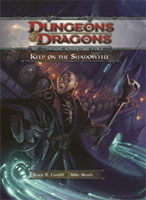 Yesterday I analyzed the shortcomings in the Chamber of Statues encounter from Keep on the Shadowfell. Today I’m going to look at how we can fix this.
Yesterday I analyzed the shortcomings in the Chamber of Statues encounter from Keep on the Shadowfell. Today I’m going to look at how we can fix this.
SPOILER WARNING!
The following thoughts contain minor spoilers for Keep on the Shadowfell. If you don’t want to be spoiled, don’t read it. And if you’re in my gaming group then you definitely shouldn’t be reading it.
THE LAYOUT
We’ll start by shifting the layout. I think there are two directions we can go with this.
CENTERPIECE: First, we can make the room larger, put the titan statue in the center of the room, and add some additional dragon statues.
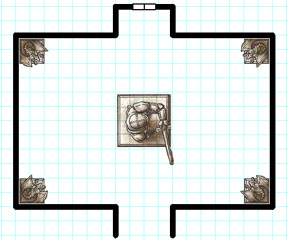
With this layout, whenever the PCs try to circle around the dangerous sweeping blow of the titan statue, the dragon statues will push them back towards the center of the room.
ILLUSION OF SAFETY: This layout has a greater similarity to the original layout and doesn’t increase the number of dragon statues.
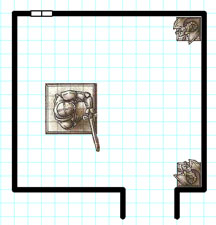
With this layout, clever PCs will notice the limited range of the titan statue’s attack and conclude that they can safely circle around it to the east. But if the try that, the dragon statues will use their force breath ability to push them back towards the titan statue.
NO CHEAP SHOTS
The dragon statues in the original encounter already have a force shot ability that interacts with the second part of this trap (which I’m not dealing with here):
FORCE SHOT (immediate reaction, when a creature makes a melee attack against a cherub statue from the exterior of the arcane cage; at will)
Range 10; +7 vs. Reflex; 1d6+6 force damage, and the target is pushed 1 square
We’re going to make an adjustment to this ability in order to stop the PCs from getting to a safe distance and then taking pot-shots at the titan statue.
DEFENSIVE FORCE SHOT(immediate reaction, when a creature makes an attack against any statue in this encounter or when they can’t use their force blow ability on their turn; at will)
Range 15; +7 vs. Reflex; 1d6+6 force damage, and the target is pushed 1 square
PROXIMITY SAFETY
We’ll use the original mechanics from the encounter to allow a character to make an Athletics check to jump onto the titan statue or the dragon statue. But we’ll add the following detail: The dragon statues won’t use their defensive force shot against any creature in the same space as another statue (the designer of the trap didn’t want to risk having the dragon statues damage the other statues).
So getting onto a statue makes a character effectively immune against the titan statue’s sweeping blow and the force abilities of the dragon statues. However, there’s a limited number of such safe zones in the encounter (particularly if you use the Illusion of Safety layout).
COOPERATION
By making the dragon statues an active part of the encounter that can’t simply be ignored, we’ve already encouraged a higher level of cooperation: The rogue can only be dealing with one statue at a time, making it necessary for the other characters to deal with the other statues (or at least take actions to avoid them until the rogue can deal with them).
However, we’ll go one step further and make it possible for more than one character specialty to work on a single statue at the same time. For the titan statue:
Thievery/Arcana: Eight successful DC 20 checks before four failures to disable the titan stone
For the dragon statues:
Thievery/Arcana: Four successful DC 20 checks before two failures to disable one of the dragon statues
Now the rogue and the wizard can work together to rapidly disable the magical statues through the combined use of their skills.
If you really wanted spice things up, you could even make it possible for the statues to be bloodied and then add the following:
Mechanical Ruin: If the statue is bloodied, it counts as 2 successes towards disabling the statue
Now everybody in the party can work to disable a statue together. Instead of having the characters race against each other (will the statue run of hit points, Thievery checks, or Arcana checks first?), all of the characters can work together towards a common goal.
This also creates a meaningful strategic choice for the group to make as they try to deal with this encounter: Do we split up and try to deal with the dragon statues separately to clear a path to the exit? Or do we all focus our efforts on disabling the tougher titan statue and reach the exit that way?
In this last section, it should be noted, I’m not just talking about adjustments to this particular trap — I’m talking about house rules which, based on what I’ve seen of 4th Edition to date, would appear to fundamentally change some of the basic ways in which the game works. But the reward appears to be gameplay which is both more interactive and offers richer strategic and tactical choices.
PROXIMITY SAFETY
We’ll use the original mechanics from the encounter to allow a character to make an Athletics check to jump onto the titan statue or the dragon statue. But we’ll add the following detail: The dragon statues won’t use their defensive force shot against any creature in the same space as another statue (the designer of the trap didn’t want to risk having the dragon statues damage the other statues).
So getting onto a statue makes a character effectively immune against the titan statue’s sweeping blow and the force abilities of the dragon statues. However, there’s a limited number of such safe zones in the encounter (particularly if you use the Illusion of Safety layout).
COOPERATION
By making the dragon statues an active part of the encounter that can’t simply be ignored, we’ve already encouraged a higher level of cooperation: The rogue can only be dealing with one statue at a time, making it necessary for the other characters to deal with the other statues (or at least take actions to avoid them until the rogue can deal with them).
However, we’ll go one step further and make it possible for more than one character specialty to work on a single statue at the same time. For the titan statue:

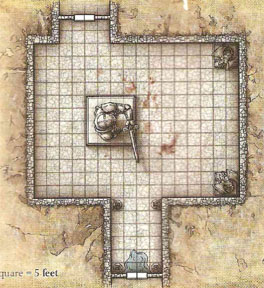 Keep on the Shadowfell has a couple of traps: There’s a bog standard pit trap. There are some runes that cause characters to flee in panic. And then there’s Area 16: The Chamber of Statues.
Keep on the Shadowfell has a couple of traps: There’s a bog standard pit trap. There are some runes that cause characters to flee in panic. And then there’s Area 16: The Chamber of Statues.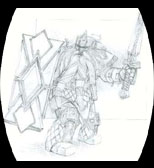 Standard Action – Melee weapon
Standard Action – Melee weapon









